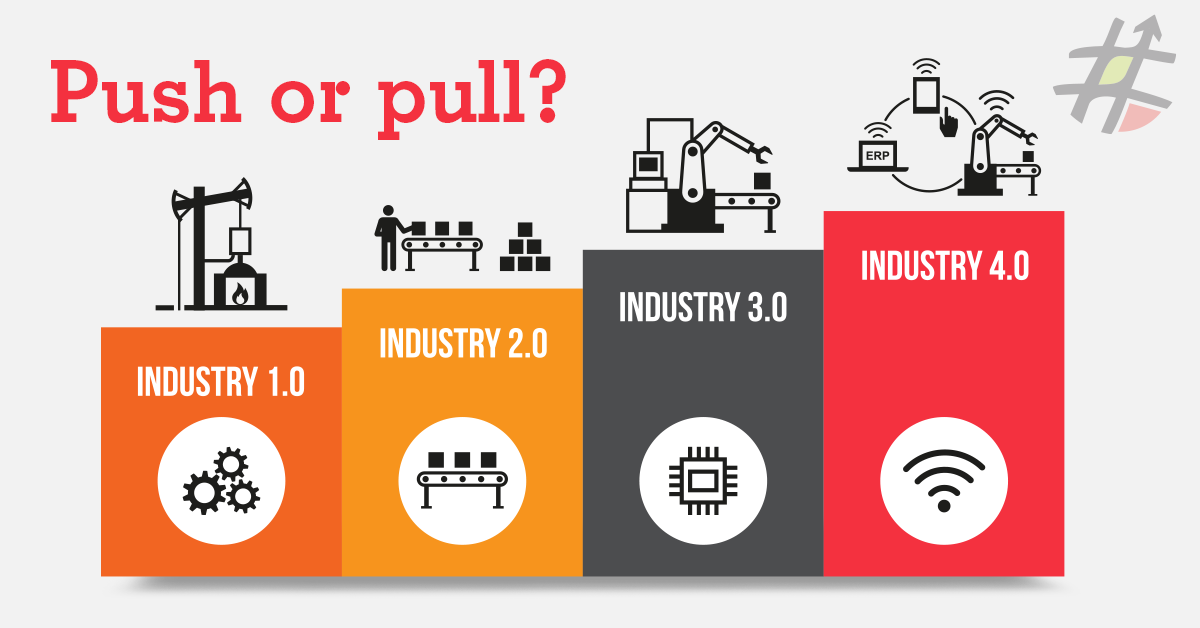What is the point of sales departments? To create markets and stoke demand.
Sales departments have been a standard part of industry for so long that we sometimes fail to remember that, for much of human history, sales activity was business to consumer. Business to business sales wasn’t a concept for a long time because manufacturing capabilities were outstripped comfortably by demand.
But the Industrial Revolution flipped that on its head. It not only allowed manufacturing at scale, but rewarded it. Because of this, sales departments were born to ‘push’ goods by creating markets and demand. This ‘push’ model of manufacturing is still dominant today, but innovation and changing social trends around consumption are forcing a change.
We’re currently in the middle of a tug-of-war between the old ‘push’ model and the new ‘pull’ model. So, what impact will Industry 4.0 have on make or buy decisions?
What is Industry 4.0?
The Australian government defines Industry 4.0 as using transformative technologies to connect the physical world to the digital world. The most tangible example would be the 3D printer, which produces physical models of virtual designs. In fact, the Australian government identifies improvements in transferring digital instructions to the physical world – such as 3D printing and robotics – as one of the key drivers of Industry 4.0.
Other drivers include:
- Rising data volumes, computational power and connectivity
- Emerging analytics and business intelligence capabilities
- New forms of human-machine interaction, such as touch interfaces, augmented and virtual reality systems.
The Pull Economy
The ‘pull’ model means manufacturing a product when there is a demand and not a moment before. In order for this type of economy to exist, 3D printing and other only-as-needed manufacturing techniques must be so efficient that the benefits of economies of scale become non-existent. We’re not there yet, and this in-between world we currently occupy has called for renewed thinking around the ‘make or buy’ debate. Do we manufacturer a product in-house, or buy it from the outside?
Going forward, many businesses will discover that they can use advancing Industry 4.0 technologies to produce components in-house. The role of procurement is to understand the trade-offs within the ‘make or buy’ debate – reducing production downtime and costs, and improving sustainable practices. But it’s about more than money, too; supply chain control, environmental sustainability and eliminating modern slavery. For the consumer, the ‘pull’ economy is all about reputation.
‘Make or buy’ revolves around a different type of green
We are steadily marching further into an era where consumers shop according to their values, helped along by eCommerce eliminating the need to buy only what’s sold locally. So, logically, if consumers no longer need to buy from you simply because there’s no one else nearby, you’ll need to provide other reasons to secure their business.
Organisations must have tighter controls over their supply chains so they can deliver the honesty and transparency demanded by an increasing number of consumers. Make or buy used to be about money. To a degree, it still is. Money will always be a motivating factor. But reputation is flexing its muscle more than ever.
Consider what could be achieved by turning the dial on nous alone.
Well, our recently upgraded commercial acumen short course builds nous, quickly. Boosting your acumen will impact on how you operate, interact and influence.
The course requires x2 half-days from you (1 full day) in a virtual online setting (no need to travel). It is delivered by one of Australia’s top Procurement deal makers and offers you acumen in spades! It is perfect for those starting out in a commercial role, equally it can be used it to inspire new thinking around commercial value.
Get the course outline here >









